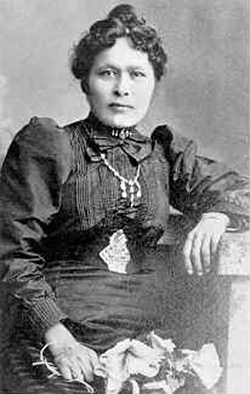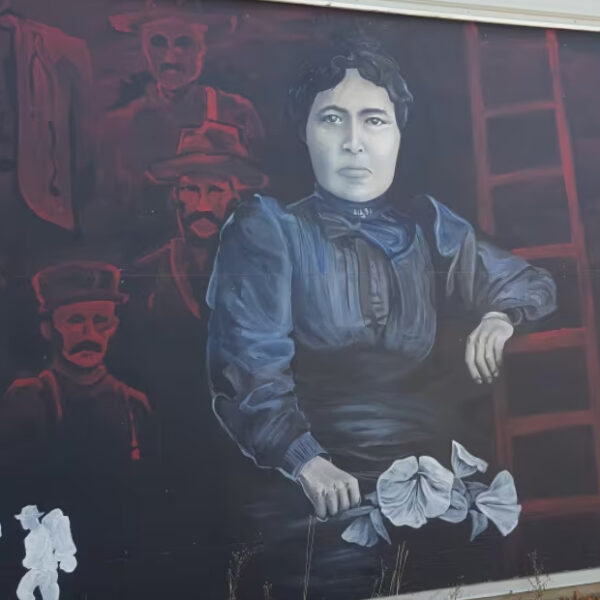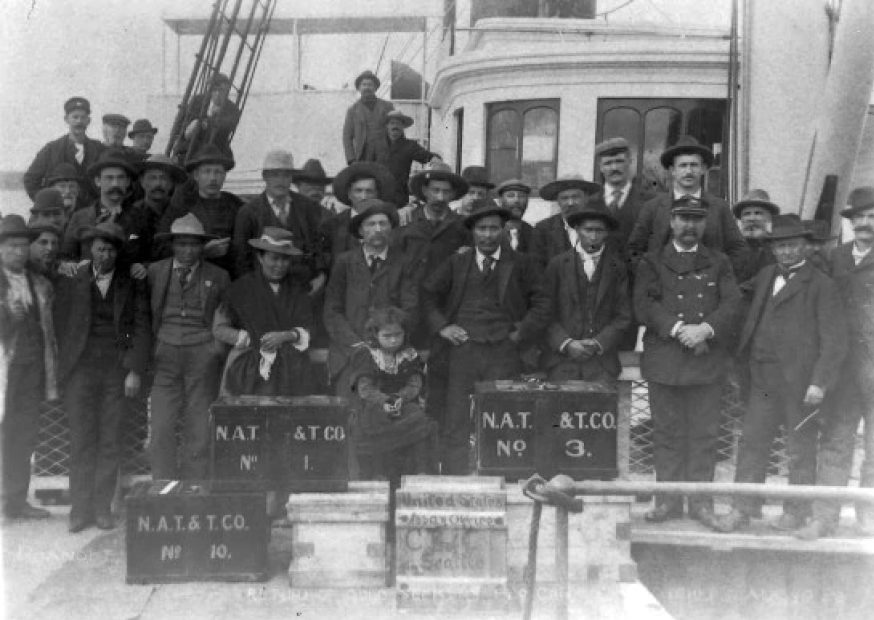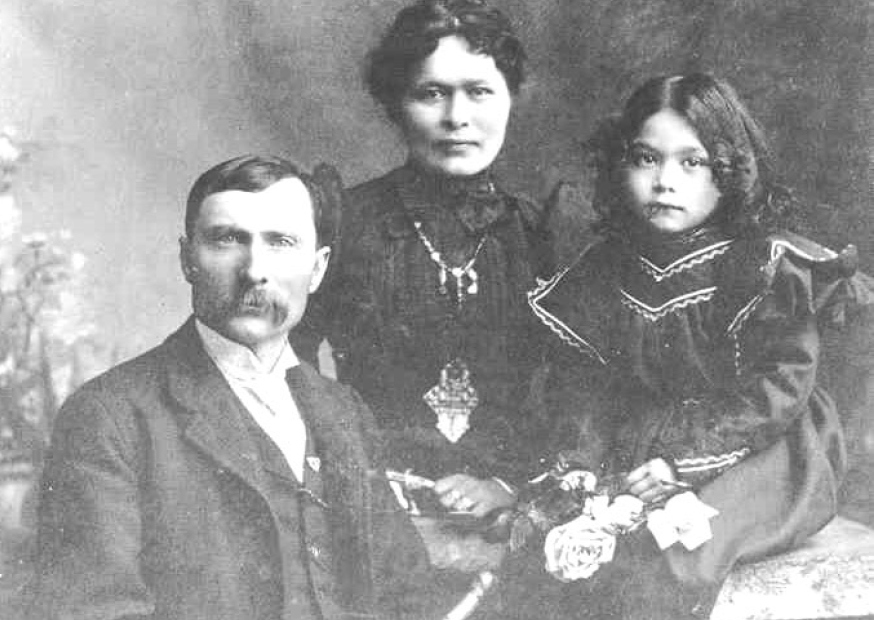Kate Carmack features prominently in a mural painted on the side of the Yukon Chamber of Mines building in Whitehorse.
Her first husband (a Tinglit man) and her daughter passed away during the influenza epidemic that ravaged Alaska around 1886. Shaaw Tláa returned to her Tagish family and met George Carmack, a white American who had deserted the U.S. Marine Corps and tried his luck as a rancher and shepherd before moving to Alaska to prospect.
Shaaw Tláa and George Carmack married in 1886 or 1887. However, there was no legal (read: settler) record of their marriage, which would later cause difficulties for Shaaw Tláa. It was George who gave her the English name ‘Kate’.
In 1889, George Carmack and Shaaw Tláa set off in search of gold. For the first 10 years of their marriage, they traveled the Forty Mile district of the Yukon, hunting, trapping, trading and placer mining. To support herself and her husband, Shaaw Tláa sewed clothing to sell to miners, hunted game, caught fish and gathered food.
In 1896, Shaaw Tláa’s brother Skookum Jim and her nephew Dawson Charlie joined the couple, and on August 17, 1896, the four discovered gold in Rabbit Creek (later renamed Bonanza Creek), a tributary of the Klondike River. The discovery sparked the Klondike Gold Rush, which saw some 30,000 gold prospectors flock to the region and create a lasting permanent settlement in Dawson City.
Unable to cash in their riches immediately, the four discoverers spent a difficult winter in the Klondike. To survive, Shaaw Tláa continued to sell items to miners – it is said that her gloves were particularly valuable. For two seasons after that, the group exploited their gold stake and amassed a nearly million dollars, a considerable fortune in those days.
In 1898, they traveled to America with their newfound fortune. This was the first time that Shaaw Tláa ever left the far North, but alas, it was not to be a happy return. Back in Dawson City during her absence, George fell in love with a brothel keeper named Marguerite Laimee. They were married in October 1900, with George claiming that he and Shaaw Tláa were never legally married. Shaaw Tláa filed for divorce on grounds of desertion and adultery. She demanded half of the household’s assets, including Klondike claims and assets in the United States, but the case was lost and she never saw her share of the fortune that the other three discoverers amassed.
After she returned to the Yukon around the year 1900, Shaaw Tláa and her daughter Aagé (Graphie Grace) lived with the Tagish in Carcross. In 1909, Aagé went to join her father in the United States. Sadly, Shaaw Tláa never saw her again. She died in Carcross on March 29, 1920, following a flu epidemic.
For a long time, Shaaw Tláa’s role in the Klondike Gold Rush was largely forgotten. As she could neither read nor write, her story was perpetuated in oral tradition and the study of writings left by others. Today, she is just beginning to receive the credit that she deserves for the discovery of Klondike gold.
In 2018, she was inducted into Canada’s Mining Hall of Fame – a long overdue honor for an inspiring individual.
Sources:
https://www.thecanadianencyclopedia.ca/en/article/shaaw-tlaa-kate-carmack
FRENCH/FRANCAIS:
Shaaw Tláa voit le jour entre 1857 et 1867 dans la région du lac Bennet. Elle grandit dans la région centre sud du Yukon, où la famille se déplace au gré des saisons.
Son premier mari Tinglit et sa fille sont emportés par l’épidémie de grippe qui ravage l’Alaska vers 1886. Shaaw Tláa retourne à sa famille tagish et fait la rencontre de George Carmack, un Américain blanc qui a déserté le Corps des Marines des États-Unis et tenté sa chance comme éleveur et berger avant de partir en Alaska pour faire de la prospection.
Shaaw Tláa et George Carmack s’unissent en 1886 ou 1887. Or, il n’y a pas de trace juridique de leur mariage, ce qui causera plus tard des difficultés à Shaaw Tláa. C’est George qui va lui donner le nom anglais de Kate.
En 1889, George Carmack et Shaaw Tláa se mettent en quête d’or. Pendant les 10 premières années de leur mariage, ils ont parcouru le district de Forty Mile au Yukon, pratiquant la chasse, le piégeage, le commerce et l’exploitation des placers.Pour subvenir aux besoins, Shaaw Tláa coud des vêtements qu’elle vend aux mineurs, chasse le gibier, pêche le poisson et pratique la cueillette.
En 1896, le frère de Shaaw Tláa, Skookum Jim et son neveu Dawson Charlie viennent rejoindre le couple et Le 17 août 1896, les quatre découvrent de l’or dans le ruisseau Rabbit (qu’on renommera plus tard ruisseau Bonanza), un affluent de la rivière Klondike.
La découverte provoque la ruée vers l’or du Klondike, qui voit affluer quelque 30 000 chercheurs d’or dans la région et fait naître des établissements permanents, comme Dawson City. C’est un événement marquant dans l’histoire du Yukon.
Incapables d’encaisser leurs richesses aussitôt, les quatre découvreurs passent un hiver difficile au Klondike. Pour survivre, Shaaw Tláa continue de vendre des articles aux mineurs et poursuit son activité de piégeage et de cueillette. Pendant deux saisons, ils exploitent leur concession aurifère et amassent un million de dollars en or.
En 1898,ils vont voyager en Amérique avec leur fortune toute neuve. C’est la première fois que Shaaw Tláa sort du Grand Nord. Mais, de retour à Dawson City, George s’éprend d’une autre femme Marguerite Laimee, une tenancière de bordel, qu’il épouse en octobre 1900 en prétendant que lui et Shaaw Tláa n’ont jamais été mariés légalement. Shaaw Tláa demande le divorce pour motif de désertion et d’adultère. Elle exige la moitié des biens du ménage, dont les concessions au Klondike et les avoirs aux États-Unis. Elle perd sa cause et ne recevra jamais sa part de la fortune amassée.
Rentrées au Yukon vers l’an 1900, Shaaw Tláa et sa fille Aagé (Graphie Grace) vivent chez les Tagish à Carcross. En 1909, Aagé s’en va rejoindre son père aux États-Unis. Shaaw Tláa ne la reverra plus jamais. Elle mourra à Carcross, le 29 mars 1920 emportée par une épidémie de grippe.
Pendant longtemps, le rôle de Shaaw Tláa dans la ruée vers l’or du Klondike a été largement oublié. Comme elle ne savait ni lire ni écrire, son histoire s’est perpétuée dans la tradition orale et l’étude des écrits laissés par d’autres.
En 2018, elle a été intronisée au Temple de la renommée de l’industrie minière du Canada – un honneur qui aurait dû être rendu depuis longtemps à cette personne inspirante.
Légende de l’image : Kate Carmack figure en bonne place dans une peinture murale réalisée sur le côté du bâtiment de la Chambre des mines du Yukon à Whitehorse.




